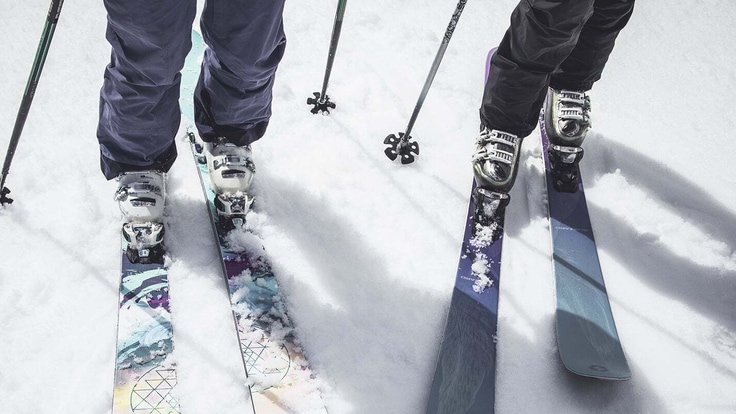Ski boots are a critical component of your ski setup, so getting the right size and fit is essential to having a fun time on the slopes.
There are several ways to ensure a great fit, including sizing the boots properly, custom molding the liners and perhaps making additional adjustments based on your stance.
See our Expert Advice article, How to Choose Downhill Ski Boots, for more information on shopping for downhill ski boots.
How to Size Ski Boots
A good ski boot fit starts with purchasing the right size boot.
Mondopoint Sizing: Most downhill ski boots use an international sizing standard that's based on the length of your foot. Most boot manufacturers express mondopoint (or mondo) sizing in centimeters.
Mondo Ski Boot Sizes Correspond to Your Foot Length
| Mondo | 21.5 | 22 | 22.5 | 23 | 23.5 | 24 | 24.5 | 25 | 25.5 | 26 |
|---|---|---|---|---|---|---|---|---|---|---|
| Foot length (in cm) | 21.5 | 22 | 22.5 | 23 | 23.5 | 24 | 24.5 | 25 | 25.5 | 26 |
This is an overly simplified chart; because mondo sizes are not uniform by brand or even from one model to another, always consult the boot sizing chart for any brand/boot you are considering. That said, you'll get a more accurate Mondo size by measuring your foot than you will using a chart to convert your U.S. shoe size. If you are between sizes, going down a half centimeter gives you a more performance-oriented fit and going up a half centimeter gives you a more comfort-oriented fit.
Going to a ski specialty shop is your best strategy for getting a good fit.
Tips for measuring your foot at home: Get two sheets of blank paper and marker. While wearing your ski socks, stand with your weight evenly distributed on each piece of paper and carefully draw the outline of each foot. Then measure the length of each foot, using the longer measurement (feet are rarely the exact same size) as your mondo size.
Boot width: The width of the inside of the ski boot at the ball of the foot is called "last width" (also sometimes referred to as "footbed width"). Last widths, which range from about 97mm to 106mm, are predetermined for each size by the boot maker. A tighter fit generally makes a boot more responsive.
Video: How to Size Ski Boots
In this short video we show you how to try on ski boots, including how to do a shell fit, how to buckle the boots and what to look for as you examine the fit.
Tips for Trying on Downhill Ski Boots
Here are some things to keep in mind when trying on downhill ski boots:
- Wear thin, synthetic ski socks. No thick hiking socks, no cotton.
- Feet tend to swell over the course of the day. Try on boots in the afternoon or evening when they are largest.
- When standing straight, your toes should brush the end of the boots, but they shouldn't be crammed or turned under.
- When in a ski-tuck position, your toes should just barely pull away from brushing the front of the boot. The fit should not be painful.
- When flexing your knees, your heels should stay down.
- Walk around and stand in the boots for at least 20 minutes.
How to Custom Mold Ski Boot Liners
Some ski boots come with liners that can be heat molded for a custom fit. If your ski boots have liners like this, you can either take them to a ski shop to be molded or you can do it at home.
If you want to mold the liners at home, here's what you'll need:
- 3-4 lbs. of uncooked white rice
- Microwave
- 2x4 piece of wood
- Two old socks you can cut up
- A pair of long thin tube socks
- A pair of thin wool or synthetic ski socks
Video: How to Custom Mold Ski Boot Liners
In this video, we show you how mold your liners at home.
Downhill Ski Boot Fit Modifications
A boot fitter can examine the shape of your foot and leg and make modifications to your boot to improve the fit and performance. Many skiers require some boot modification to get the best possible fit.
Custom insoles: Custom insoles are a popular way to improve fit and support. Your options:
- For a little extra support, try a cut-to-fit insole.
- For a more customized fit, get a custom-molded cork insole. The insole is heated, vacuum molded and massaged to fit your foot—a 25-minute process. Many REI stores make custom-molded insoles. Contact your local store to check.
- If you have known foot issues, choose a physician-made orthotic.
Canted cuffs: You may be one of the more than 75% of skiers who are knock-kneed or bowlegged. A cuff cant can help balance your stance. To check, stand with your feet aligned under your shoulders and look in a mirror. Bring your feet toward one another slowly.
- Bowlegged: Your feet touch first.
- Knock kneed: Your ankles touch first.
Cuff canting aligns the boot cuff with bowed or knock-kneed skiers. Any adjustments with the cuff should complement your stance, not alter it. Let your ski-boot specialist help you make adjustments as needed.
Other fit modifications that a professional boot fitter may recommend include:
- Using a heat gun to soften and mold the shell for more toe space.
- Using a heel wedge to lift the heel.
- Stretching or grinding the liners.
